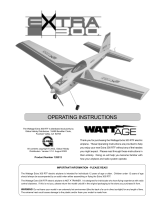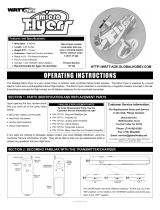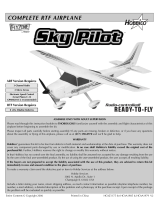
2
Need help or have any questions? Call us at 1-714-963-0329 or send us an email to service@globalhobby.net
FOR YOUR SAFETY - PLEASE READ AND UNDERSTAND THESE WARNINGS!
●
Do not fly your airplane if another airplane is on the same
frequency as you. The frequency number is printed on the
front of the radio transmitter.
●
Never fly your airplane from the street or at night.
Always fly in an open area free of obstructions.
●
When flying, make sure any spectators are behind you.
●
Always be conscious of the spinning propeller. Be careful
not to allow loose clothing to be drawn into the propeller.
●
Because your airplane is operated by radio control, it is
important to make sure you are always using fresh and/or
fully charged batteries. Never allow the batteries to run low
or you could lose control of the airplane.
●
Never attempt to disassemble any of the airplane's
components, especially the transmitter and flight battery.
●
Do not allow any of the components to get wet or
electrical damage may occur.
●
You should complete a successful range check of your
radio equipment prior to each new day of flying, or prior to
the first flight of a new or repaired airplane.
●
If your airplane gets dirty, do not use any solvents to clean
it. Solvents will damage the foam and plastic. Use a dry
cloth to clean any dirt from the outside of the airplane.
GENERAL WARNINGS
●
Never overcharge the flight battery or damage to the flight
battery may occur.
●
To prevent the flight battery from overheating during the
charging process, allow the flight battery to completely
cool before recharging it.
●
Always completely discharge the flight battery by running
the motor until it stops, before recharging the flight
battery.
●
Always turn on the transmitter before turning on the
airplane and always turn off the airplane before turning off
the transmitter.
●
Always unplug the flight battery when not flying the
airplane.
●
Never cut the receiver antenna shorter or you could lose
control of the airplane during flight.
●
When flying the airplane, make sure the transmitter
antenna is completely extended.
● Never attempt to disassemble or modify any of the radio
system components.
FLIGHT BATTERY WARNINGS
RADIO SYSTEM WARNINGS
If you should have any trouble with any of the steps listed in these operating instructions, we have provided a
troubleshooting guide on page # 16. The troubleshooting guide is provided to help you find a quick and immediate
resolution to any number of problems that might occur. If you cannot solve a problem using the troubleshooter, or if
you have any other questions or concerns, please contact us at the locations below:
Global Services
18480 Bandilier Circle
Fountain Valley CA 92708
Phone: (714) 963-0329 Fax: (714) 964-6236 Email: service@globalhobby.net
On the Web
http://globalservices.globalhobby.com
FOR YOUR INFORMATION
OUR GUARANTEE
Wattage guarantees this kit to be free from defects in both material and workmanship at the date of purchase. This does not cover any component
parts damaged by use, misuse or modification. In no case shall Wattage's liability exceed the original cost of the purchased kit.
In that Wattage has no control over the final assembly or material used for final assembly, no liability shall be assumed for any damage resulting from
the use by the user of the final user-assembled product. By the act of using the final user-assembled product, the user accepts all resulting liability.


































